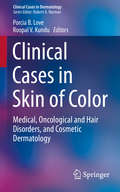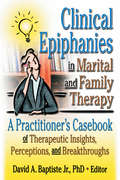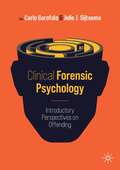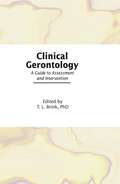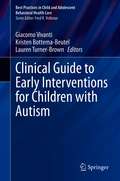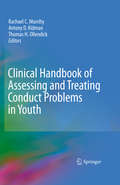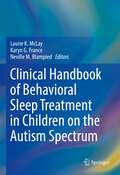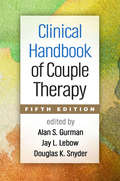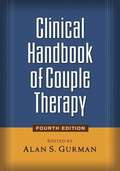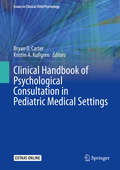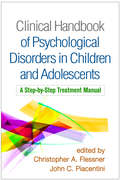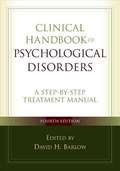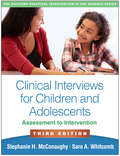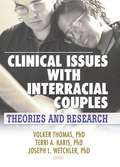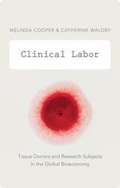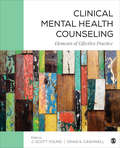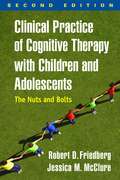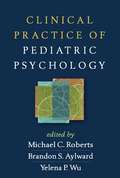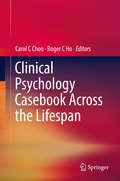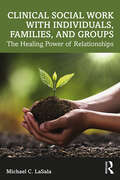- Table View
- List View
Clinical Casebook of Couple Therapy
by Alan GurmanVividly depicting the process of therapy, this instructive casebook presents in-depth illustrations of treatment based on the most important couple therapy models. An array of leading clinicians offer a window onto how they work with clients grappling with mild and more serious clinical concerns, including conflicts surrounding intimacy, sex, power, and communication; parenting issues; and mental illness. Featuring couples of varying ages, cultural backgrounds, and sexual orientations, the cases shed light on both what works and what doesn't work when treating intimate partners. Each candid case presentation includes engaging comments and discussion questions from the editor.
Clinical Cases in Skin of Color: Medical, Oncological and Hair Disorders, and Cosmetic Dermatology (Clinical Cases in Dermatology)
by Porcia B. Love Roopal V. KunduThis book will identify the top dermatological conditions for patients with skin of color and provide essential features which contrast these conditions in darker skin types. The reader will be able to formulate informed treatment regimens for patients with skin of color. The book will also provide clinical pearls to guide decision making, as well as important cultural beliefs that must be considered in order to provide optimal care to patients with skin of color. Clinical cases are a key component in modern medical education, assisting the trainee or recertifying clinician to work through unusual cases using best practice techniques. Dermatology is an important discipline in this regard since it is a highly visual subject requiring the reader to describe often very subtle differences in the presentation of patients and define accurately the diagnostic and management criteria to base their clinical decision-making on. By the year 2050, people with skin of color (including Africans, African Americans, Asians, Native Americans and Hispanics) will represent more than half of the U. S. population. There is now an increasing demand for dermatologic treatments in patients with skin of color, as well as an accompanying need for education and training in this quickly expanding market. Skin of Color is a key topic within dermatology as specific conditions can be harder to diagnose effectively in darker skin, and their treatment can be compromised by this. Conditions such as psoriasis, eczema, and atopic dermatitis may be more difficult to diagnose in darker skin. There are various other conditions that can provide a challenge in management, including postinflammatory hyperpigmentation, melasma, scarring, alopecias, and pseudofolliculitis barbae. If these skin disorders are not diagnosed and treated properly, the initial lesions can become darker as they heal, and the darker spots can last for years in some cases.
Clinical Epiphanies in Marital and Family Therapy: A Practitioner's Casebook of Therapeutic Insights, Perceptions, and Breakthroughs
by David A. BaptisteHow would you handle these situations? Check your expertise against the approaches presented here!This fascinating collection shows how a practicing therapist handled clients stuck in the therapeutic process. Clinical Epiphanies in Marital and Family Therapy: A Practitioner’s Casebook of Therapeutic Insights, Perceptions, and Breakthroughs presents a cross-section of approaches and orientations as they work in practice. The families and couples discussed here have experienced a wide range of difficulties, and the presenting and commenting therapists run the gamut in age, gender, race, and theoretical orientation.The serendipitous turning points presented here are all true case studies, but Clinical Epiphanies in Marital and Family Therapy offers more than the chance to second-guess a single therapist’s handling of explosive moments. Each case study is also discussed by two other therapists representing divergent points of view. This point-counterpoint structure allows readers to analyze the effectiveness of different therapeutic approaches and to recognize that in practice, heterogeneous orientations may result in similar strategies.Clinical Epiphanies in Marital and Family Therapy demonstrates the factors that contribute to doing successful therapy, including: ensuring that clients feel they are being treated with respect establishing a sound therapeutic relationship making successful treatment bargains moving away from your therapeutic agenda when necessary being persistent in the face of a stubborn refusal to changeClinical Epiphanies in Marital and Family Therapy offers fresh strategies for experienced practitioners, beginning therapists, and educators in the field of mental health.
Clinical Ethics on Film: A Guide for Medical Educators
by M. Sara RosenthalThis book discusses feature films that enrich our understanding of doctor-patient dilemmas. The book comprises general clinical ethics themes and principles and is written in accessible language. Each theme is discussed and illuminated in chapters devoted to a particular film. Chapters start with a discussion of the film itself, which shares details behind the making of the film; critical reception; casting and other facts about production. The chapter situates the film in a history of medicine and medical sociology context, analyzes ethical issues raised in the film from a clinical ethics lens, and explains to readers how to use each film as a teaching aid for clinical ethics. Readers will understand how each film in this collection served to bring particular clinical ethics issues to the public’s attention, or reflected medico-legal issues that were part of the public discourse. The book is a perfect instructor's guide for anyone teaching bioethics, healthcare ethics, medical sociology, medical history, healthcare systems narrative medicine, or nursing ethics.
Clinical Forensic Psychology: Introductory Perspectives on Offending
by Carlo Garofalo Jelle J. SijtsemaThis book represents a comprehensive collection of theoretical and empirical work at the nexus of clinical and forensic psychology written by world-renowned experts in the field. It is among the first books in the field to focus entirely on clinical psychological science applied to the understanding and treatment of offending. Part I addresses the main theoretical and clinical models used to explain and predict antisocial behavior, spanning biological, cognitive, experimental, individual differences, and interpersonal perspectives. Part II focuses on forms of psychopathology associated with an increased tendency to offend, with the emphasis on describing the clinical constructs most relevant for forensic psychology. Each chapter describes the clinical characteristics of one form of psychopathology, their assessment, their links with antisocial behavior, and treatment considerations. Part III focuses on different types of offense or offender groups as starting points. This perspective has relevance since many criminal justice and forensic mental health systems allocate offenders to interventions based on their index offense (or history of offenses). Finally, Part IV addresses the application of clinical psychology in the service of assessment and treatment in forensic settings. It includes the state of the art on diagnostic and risk assessment, as well as both widely used and recently developed interventions. This book is an excellent resource for students at both Bachelor’s and Master’s level, while also representing a comprehensive handbook for experienced researchers and practitioners.
Clinical Gerontology: A Guide to Assessment and Intervention
by T.L. BrinkHere is a major text in psychogeriatrics for all professionals in the field of aging and mental health. Leading authorities provide valuable insights into assessment and intervention techniques for use with the mentally impaired elderly. Topics include a depression scale for use in later life, family therapy, therapy in later life, and various issues concerning mental health care for the aged.
Clinical Guide to Early Interventions for Children with Autism (Best Practices in Child and Adolescent Behavioral Health Care)
by Giacomo Vivanti Kristen Bottema-Beutel Lauren Turner-BrownThis book examines early interventions for children with autism spectrum disorder (ASD) with the goal to enable primary care physicians as well as other clinicians, therapists, and practitioners to assist parents in making informed decisions based on current research. It provides a map for successfully navigating the maze of early interventions for ASD, focusing on evidence. Chapters review the similarities and differences between current evidence-based treatments, how these treatments work, the factors that facilitate their effectiveness, and the pros and cons of their use for different children and different needs. In addition, chapters discuss the services, laws, policies, and societal issues related to early intervention in ASD. Featured topics include:Criteria to evaluate evidence in ASD interventions.Effective approaches for Social communication difficulties in ASD.Effective approaches for Restricted and repetitive behaviors (RRBs) in ASD.Naturalistic, developmental approaches to early intervention for children with ASDThe TEACCH approach and other visually based approaches for children with ASD.Applied Behavior Analysis (ABA) approaches to early intervention for children with ASD.What works for whom in ASD early intervention Clinical Guide to Early Interventions for Children with Autism is an essential resource for clinicians, primary care providers, and other practitioners as well as researchers, professors, and graduate students in the fields of child, school, and developmental psychology, pediatrics, social work, child and adolescent psychiatry, primary care medicine, and related disciplines.
Clinical Handbook of Assessing and Treating Conduct Problems in Youth
by Rachael C. Murrihy Thomas H. Ollendick Antony D. KidmanConduct problems, particularly oppositional defiant disorder (ODD) and conduct disorder (CD), are the most common mental health problems affecting children and adolescents. The consequences to individuals, families, and schools may be severe and long-lasting. To ameliorate negative outcomes and ensure the most effective treatment for aggressive and antisocial youth, early diagnosis and evidence-based interventions are essential. Clinical Handbook of Assessing and Treating Conduct Problems in Youth provides readers with both a solid grounding in theory and a comprehensive examination of the evidence-based assessment strategies and therapeutic practices that can be used to treat a highly diverse population with a wide range of conduct problems. It provides professional readers with an array of evidence-based interventions, both universal and targeted, that can be implemented to improve behavioral and social outcomes in children and adolescents. This expertly written resource: Lays the foundation for understanding conduct problems in youth, including epidemiology, etiology, and biological, familial, and contextual risk factors.Details the assessment process, with in-depth attention to tools, strategies, and differential diagnosis.Reviews nine major treatment protocols, including Parent-Child Interaction Therapy (PCIT), multisystemic therapy (MST) for adolescents, school-based group approaches, residential treatment, and pharmacotherapy.Critiques the current generation of prevention programs for at-risk youth.Explores salient issues in working effectively with minority youth.Offers methods for evaluating intervention programs, starting with cost analysis.This volume serves as a one-stop reference for all professionals who seek a solid grounding in theory as well as those who need access to evidence-based assessment and therapies for conduct problems. It is a must-have volume for anyone working with at-risk children, including clinical child, school, and developmental psychologists; forensic psychologists; social workers; school counselors and allied professionals; and medical and psychiatric practitioners.
Clinical Handbook of Behavioral Sleep Treatment in Children on the Autism Spectrum
by Laurie K. McLay Karyn G. France Neville M. BlampiedThis handbook provides an overview of the nature, prevalence, and causes of sleep problems in children with autism spectrum disorder (ASD) and examines the process of using functional behavior assessment (FBA) to treat sleep disorders. It describes several evidence-based treatments and explores how these align with the outcomes of the FBA process, including case illustrations of the assessment and treatment process. The handbook discusses the application of FBA in family contexts, including:The effects on children and families of successful interventions with sleep.How to conduct FBA with clinically complex families.Including the child in the intervention.The evidence of efficacy of other treatment approaches. The handbook addresses sleep problems that are highly prevalent among children and young people with ASD, including sleep onset delay, frequent and prolonged night waking, and unwanted co-sleeping. It explores the profound secondary effects that sleep problems may have on children’s daytime functioning as well as child and parent health and wellbeing. The handbook discusses the causes of sleep problems in individuals with ASD, which may be multifaceted and complex and include physiological, environmental, cognitive etiologies yet almost always have a behavioral or learned component. It examines how FBA can be used to characterize challenging behaviors and identify the antecedents (e.g., environmental context) and consequences that affect such behaviors. The volume details the process of using FBA to assess and treat sleep problems in children with ASD. Clinical Handbook of Behavioural Sleep Treatment in Autism is a must-have resource for clinicians, therapists, and other practitioners as well as researchers and graduate students in clinical child and school psychology, behavioral therapy, social work, public health, developmental psychology, pediatrics, family studies, and child and adolescent psychiatry.
Clinical Handbook of Couple Therapy
by Jay L. Lebow Douglas K. SnyderNow in a significantly revised sixth edition with 70% new material, this comprehensive handbook has introduced tens of thousands of practitioners and students to the leading forms of couple therapy practiced today. Prominent experts present effective ways to reduce couple distress, improve overall relationship satisfaction, and address specific relational or individual problems. Chapters on major approaches follow a consistent format to help readers easily grasp each model's history, theoretical underpinnings, evidence base, and clinical techniques. Chapters on applications provide practical guidance for working with particular populations (such as stepfamily couples and LGBT couples) and clinical problems (such as intimate partner violence, infidelity, and various psychological disorders). Instructive case examples are woven throughout. New to This Edition *Chapters on additional clinical approaches: acceptance and commitment therapy, mentalization-based therapy, intergenerational therapy, socioculturally attuned therapy, and the therapeutic palette approach. *Chapters on sexuality, older adult couples, and parents of youth with disruptive behavior problems. *Chapters on assessment and common factors in couple therapy. *Chapters on cutting-edge special topics: relationship enhancement, telehealth interventions, and ethical issues in couple therapy.
Clinical Handbook of Couple Therapy, Fifth Edition
by Alan S. Gurman Jay L. Lebow Douglas K. SnyderRegarded as the authoritative reference and text, this handbook presents the most effective, widely studied approaches to couple therapy. The distinguished coeditors bring together other leading experts, most of whom developed the approaches they describe. Adhering closely to a uniform structure to facilitate study and comparison, chapters cover the history, theoretical and empirical underpinnings, and techniques of each model. The volume also describes cutting-edge applications for particular relationship contexts (such as blended families, LGBT couples, and separated couples) and clinical problems (such as partner aggression, psychological disorders, and medical issues). New to This Edition *Chapters on interpersonal neurobiology and intercultural relationships. *Chapters on couple therapy for PTSD, functional analytic couple therapy, and the integrative problem-centered metaframeworks approach. *Many new authors; extensively revised with the latest theory and research. See also Clinical Casebook of Couple Therapy, edited by Alan S. Gurman, which presents in-depth illustrations of treatment.
Clinical Handbook of Couple Therapy, Fourth Edition
by Alan GurmanThis authoritative handbook provides a definitive overview of the theory and practice of couple therapy. Noted contributors--many of whom developed the approaches they describe--combine clear conceptual exposition with thorough descriptions of therapeutic techniques. In addition to presenting major couple therapy models in step-by-step detail, the book describes effective applications for particular populations and problems. Chapters adhere closely to a uniform structure to facilitate study and comparison, enhancing the book's utility as a reference and text. New to This Edition 11 new chapters. Numerous new and revised case examples. The latest data and clinical techniques. Expanded introductory chapter that reviews key concepts and themes. Up-to-date coverage of gender issues, lesbian and gay couples, and cultural diversity.
Clinical Handbook of Psychological Consultation in Pediatric Medical Settings (Issues in Clinical Child Psychology)
by Bryan D. Carter Kristin A. KullgrenThis handbook examines pediatric consultation-liaison psychology in pediatric medical settings. It offers a brief history of pediatric psychologists’ delivery of consultation-liaison services. The handbook provides an overview of roles, models, and configurations of pediatric psychology practice in diverse inpatient and outpatient medical settings. Chapters discuss the most frequently seen major pediatric conditions encountered in consultation practice. Coverage includes evaluation, intervention, and treatment of each condition. Each clinical condition addresses the referral problem in the context of history and family dynamics. In addition, chapters address important aspects of the management of a consultation-liaison service and provide contextual issues in delivering evidence-based services in hospital and medical settings. Topics featured in this handbook include:The role of assessment in the often fast-paced medical environment.Modifications of approaches in the context of disorders of development.Consultation on pediatric gender identity.The presentation of child maltreatment in healthcare settings.The use of technological innovations in pediatric psychological consultation.Important ethical considerations in consultation-liaison practice. Clinical Handbook of Psychological Consultation in Pediatric Medical Settings is a must-have resource for clinicians and related professionals as well as researchers, professors, and graduate students in pediatric and clinical child and adolescent psychology, pediatrics, social work, developmental psychology, child and adolescent psychiatry, and related disciplines.
Clinical Handbook of Psychological Disorders in Children and Adolescents: A Step-by-Step Treatment Manual
by Christopher A. Flessner John C. PiacentiniBringing together leading authorities, this volume synthesizes the breadth of current research on child and adolescent treatment into a practical handbook for students and clinicians. The book was inspired by the preeminent work on adult disorders, Clinical Handbook of Psychological Disorders (now in its fifth edition). It provides a concise overview of the disorders most commonly encountered in clinical practice and details evidence-based treatment approaches, largely grounded in cognitive-behavioral therapy (CBT). Procedures for assessment, diagnosis, case formulation, intervention, and progress monitoring are illustrated with rich extended case examples, including session transcripts. The book addresses nuts-and-bolts issues such as how to set up each session, what to cover, and how to broach difficult topics with children and parents. See also Clinical Handbook of Psychological Disorders, Fifth Edition (on adults), edited by David H. Barlow.
Clinical Handbook of Psychological Disorders, Fourth Edition
by David BarlowWith over 75,000 copies sold, this clinical guide and widely adopted text presents authoritative guidelines for treating frequently encountered adult disorders. The Handbook is unique in its focus on evidence-based practice and its attention to the most pressing question asked by students and practitioners "How do I do it?" Leading clinical researchers provide essential background knowledge on each problem, describe the conceptual and empirical bases of their respective approaches, and illustrate the nuts and bolts of evidence-based assessment and intervention. New to This Edition Incorporates treatment innovations and new empirical findings. Additional treatment protocols behavioral activation for depression, psychological treatments for positive symptoms of schizophrenia, and unified approaches to emotional disorders and eating disorders.
Clinical Handbook of Transcultural Infant Mental Health
by Felipe Lecannelier J. Martin Maldonado-Duran Andrés Jiménez-Gómez Maria X. Maldonado-MoralesThis handbook provides a review of relevant topics concerning the interface between culture and mental health, with a particular focus on child-rearing practices and transcultural issues in the perinatal period, infancy, and early childhood. It discusses how to work with infants and families from diverse backgrounds and addresses the most common issues that medical and mental health experts may encounter when working with individuals from other cultures. Chapters examine the considerable range of child-rearing strategies and how families from various cultural groups approach issues such as infant sleep, feeding practices, and care during pregnancy. In addition, chapters address conditions that are seen mostly within a particular sociocultural context and are “culture bound” syndromes or states. The handbook concludes with the editors’ recommendations for future research directions. Topics featured in this handbook include:Prejudice, discrimination, and stereotyping within the clinical field.Cultural responses to infant crying and irritability.Cultural issues in response to chronic conditions and malformations in infancy.The healthy immigrant effect.The use of folk and traditionally therapeutic remedies. The Clinical Handbook of Transcultural Infant Mental Health is an essential resource for researchers, clinicians and related professionals, and graduate students in infancy and early child development, child and school psychology, pediatrics, social work, obstetrics, and nursing.
Clinical Interviews for Children and Adolescents, Third Edition: Assessment to Intervention (The Guilford Practical Intervention in the Schools Series)
by Sara A. Whitcomb Stephanie H. McConaughyWidely recognized as an authoritative resource, this book has been revised and updated with the latest research and techniques, including new material on telehealth services. Guidelines are provided for conducting thorough, developmentally informed interviews with K–12 students--and their parents and teachers--for multimethod assessment and intervention planning. Extensive case examples illustrate how to elicit information about school functioning, peer relations, emotional and behavioral difficulties, family situations, and adolescent concerns. Two guest authors have contributed chapters on suicide and violence risk assessments. In a convenient large-size format, the book includes over a dozen reproducible interviewing tools; purchasers get access to a Web page where they can download and print the reproducible materials. New to This Edition *Incorporates the latest information on bullying, cyberbullying, and victimization; sexual- and gender-minority youth; social media and smartphone use; and adolescent substance use. *Discusses strategies, tips, and caveats for conducting virtual interviews. *Expanded coverage of cultural and linguistic biases in assessment and how practitioners can build multicultural competence. *Revised and expanded reproducible tool: Semistructured Student Interview--Second Edition. This book is in The Guilford Practical Intervention in the Schools Series, edited by Sandra M. Chafouleas.
Clinical Issues with Interracial Couples: Theories and Research
by Joseph L. Wetchler Volker Thomas Terri KarisGo beyond cookie-cutter therapy and interventions to provide culturally relevant therapy that works for your clients in interracial relationships! With this book, you'll explore an array of relational issues faced by various configurations of interracial couples. Then you'll learn specific intervention strategies for treating these couples in therapy. The first section presents research and theoretical chapters on issues faced by interracial couples who are heterosexual; the second focuses on issues facing racially mixed gay and lesbian couples; and the third provides you with specific interventions to use with couples in interracial relationships. Clinical Issues with Interracial Couples: Theories and Research is an important addition to the collection of any therapist who counts an interracial couple among his or her clients. From the editors: "Although interracial couples face challenges related to differences in their racial backgrounds, couple and family theories have had little to say about how to work with these differences. Not all couples are white, married, and heterosexual, and there is a growing understanding that clinical practices based on these assumptions may not be adequate when working with interracial couples. Recognizing the diversity of our clients, the intent of this book is to contribute to more respectful and inclusive clinical practices that can address the treatment issues we face in the first decade of the twenty-first century." The first section of this book examines challenges faced by heterosexual interracial couples, focusing on: how black/white couples experience and respond to racism and how they negotiate the racial and ethnic differences they face in their relationships the significance of race-or lack of it-in white women's relationships with black men, with suggestions on how to create a therapeutic space for discussing race without over-determining its significance marriages where one partner is of Latino/a descent and the other of non-Latino/a white descent-a pilot study of a rarely investigated population! approaches, interventions, and strategies to use when treating multicultural Muslim couples Hawaii's unusual history of interracial ties and relationships, the common challenges that face interracial couples there, and therapeutic interventions that can benefit them The second section of Clinical Issues with Interracial Couples looks at the issues faced by same-sex interracial couples. Here is a sample of what you'll find: clinical considerations for working with interracial/intercultural lesbian couples pitfalls to avoid in therapy as well as suggestions for a conceptual approach for gay Latino men in cross-cultural relationships The book's final section presents interventions for use with interracial couples. Here you'll find: assessment techniques and interventions geared toward black-white couples information on doing effective therapy with Latino/a-white couples a case study of the therapeutic process as applied to an Asian-American woman married to a white man seven therapists' perspectives on working with interracial couples-focusing on the historical context of intermarriage, specific concerns and issues that interracial couples experience in their relationships, and the experiences of therapists working with this diverse and challenging client population
Clinical Labor: Tissue Donors and Research Subjects in the Global Bioeconomy
by Catherine Waldby Melinda CooperForms of embodied labor, such as surrogacy and participation in clinical trials, are central to biomedical innovation, but they are rarely considered as labor. Melinda Cooper and Catherine Waldby take on that project, analyzing what they call "clinical labor," and asking what such an analysis might indicate about the organization of the bioeconomy and the broader organization of labor and value today. At the same time, they reflect on the challenges that clinical labor might pose to some of the founding assumptions of classical, Marxist, and post-Fordist theories of labor.Cooper and Waldby examine the rapidly expanding transnational labor markets surrounding assisted reproduction and experimental drug trials. As they discuss, the pharmaceutical industry demands ever greater numbers of trial subjects to meet its innovation imperatives. The assisted reproductive market grows as more and more households look to third-party providers for fertility services and sectors of the biomedical industry seek reproductive tissues rich in stem cells. Cooper and Waldby trace the historical conditions, political economy, and contemporary trajectory of clinical labor. Ultimately, they reveal clinical labor to be emblematic of labor in twenty-first-century neoliberal economies.
Clinical Mental Health Counseling: Elements of Effective Practice
by Craig S. Cashwell J. Scott YoungReferencing the 2016 CACREP standards, Clinical Mental Health Counseling: Elements of Effective Practice combines solid foundational information with practical application for a realistic introduction to work in community mental health settings. Top experts in the field cover emerging models for clinical interventions as they explore cutting-edge approaches to CMH counseling. With case studies integrated throughout, students will be well prepared to move into practicum and internship courses as well as field-based settings. "An instant classic. Young and Cashwell have assembled a stellar group of counselor education authors and produced an outstanding, comprehensive, and easy-to-read text that clearly articulates and elevates the discipline of clinical mental health counseling. This book covers everything a CMHC needs to hit the ground running in clinical practice!" —Bradley T. Erford, Loyola University Maryland, Past President of the American Counseling Association
Clinical Mental Health Counseling: Elements of Effective Practice
by Craig S. Cashwell J. Scott YoungReferencing the 2016 CACREP standards, Clinical Mental Health Counseling: Elements of Effective Practice combines solid foundational information with practical application for a realistic introduction to work in community mental health settings. Top experts in the field cover emerging models for clinical interventions as they explore cutting-edge approaches to CMH counseling. With case studies integrated throughout, students will be well prepared to move into practicum and internship courses as well as field-based settings. "An instant classic. Young and Cashwell have assembled a stellar group of counselor education authors and produced an outstanding, comprehensive, and easy-to-read text that clearly articulates and elevates the discipline of clinical mental health counseling. This book covers everything a CMHC needs to hit the ground running in clinical practice!" —Bradley T. Erford, Loyola University Maryland, Past President of the American Counseling Association
Clinical Practice of Cognitive Therapy with Children and Adolescents, Second Edition
by Robert D. Friedberg Jessica M. McclureWidely regarded as the definitive practitioner reference and teaching text, this book provides a complete introduction to doing cognitive-behavioral therapy (CBT) with 6- to 18-year-olds. The authors offer a blueprint for formulating cases and tailoring treatment to each child's or adolescent's unique developmental and clinical needs. Coverage includes how to orient children and families to cognitive therapy, structure each session, and implement a wide range of CBT techniques. Rich case material illustrates ways that CBT can help children struggling with specific emotional and behavioral problems. Reproducible forms and handouts can be downloaded and printed in a convenient 8 1/2" x 11" size. New to This Edition *Incorporates the latest advances in CBT with youth and gives increased attention to cultural issues, including new case examples. *Chapter on working with patients with autism spectrum disorder. *Chapter on cognitive-behavioral family therapy. *Pull-out boxes throughout that summarize key points. *Epilogue on developing clinical wisdom. See also the authors' Cognitive Therapy Techniques for Children and Adolescents: Tools for Enhancing Practice, which presents creative ways to address challenging problems.
Clinical Practice of Pediatric Psychology
by Michael C. Roberts Yelena P. Wu Brandon S. AylwardFilled with vivid clinical material, this book describes effective practices for helping children and their families who are coping with chronic and acute health conditions and their treatment. Concise chapters on the psychosocial challenges associated with specific pediatric health conditions are organized around detailed case presentations. Demonstrating procedures for assessment, case conceptualization, brief intervention, and health promotion, the book highlights ways to collaborate successfully with medical providers and families. Chapters also discuss the varied roles that pediatric psychologists play in hospitals, outpatient clinics, primary care, and educational settings. See also Handbook of Pediatric Psychology, Fourth Edition, edited by Michael C. Roberts and Ric G. Steele, which comprehensively examines links between psychological and medical issues from infancy through adolescence.
Clinical Psychology Casebook Across the Lifespan
by Carol C Choo Roger C HoThis book illustrates the multifaceted applications of clinical psychology in multi-cultural contexts. It considers people’s emotional, cognitive, interpersonal and psychological development across their lifespans. The book explores nine multicultural clinical cases that illustrate clinical assessment, biopsychosocial formulation, and evidence-based therapy. Further, it provides therapy outcomes for diverse clients throughout their lifespans, e.g. for cognitive behavioral therapy, integrative therapy, and narrative therapy; and examines clinical findings on e.g. social and emotional development, family trauma, child sexual abuse and its impact, as well as culturally sensitive assessment and interventions for a range of mental health issues. Further cases focus on co-morbid conditions, and physical ailments, across the lifespan.Bringing together contributions from both academics and practitioners, the book illustrates practical applications of theories and concepts relevant to the practice of clinical psychology. It also reviews the relevant literature with clinical recommendations, and provides multicultural perspectives and insights into contemporary clinical approaches from experienced clinical supervisors and practitioners, who are also academics and educators in the field. Accordingly, the book offers a valuable asset for students, academics, researchers and practitioners, as well as for postgraduate clinical training.
Clinical Social Work with Individuals, Families, and Groups: The Healing Power of Relationships
by Michael C. LaSalaThis textbook equips Masters of Social Work (MSW) students and beginning social workers with the personal and professional tools needed to work successfully with individuals, families, and groups, guided by the social justice values of the profession. This book is a comprehensive description of practical, field-tested, ready-to-apply interventions based on the author’s 40 years of practice, as well as his national and international teaching, training, and supervision. By drawing case illustrations from composites of actual practice, he demonstrates how to apply various models, as well as how to identify, avoid, and rectify clinical errors. This book also provides core understandings and techniques from models of psychotherapy alongside essential clinical skills that cut across these approaches, such as engagement, establishing therapeutic relationships, managing one’s anxiety, reaching for pain, and the clinician’s use of self. Filled with reflective questions and ideas for class discussion, the book addresses how to heal relationships across all contexts, such as with clients in diverse and oppressed groups and doing clinical social work during the age of Covid. Providing a description of clinical social work that is congruent with diversity, equity, and social justice, this excellent textbook is for students and instructors of MSW courses and will prove indispensable to beginning practitioners.

